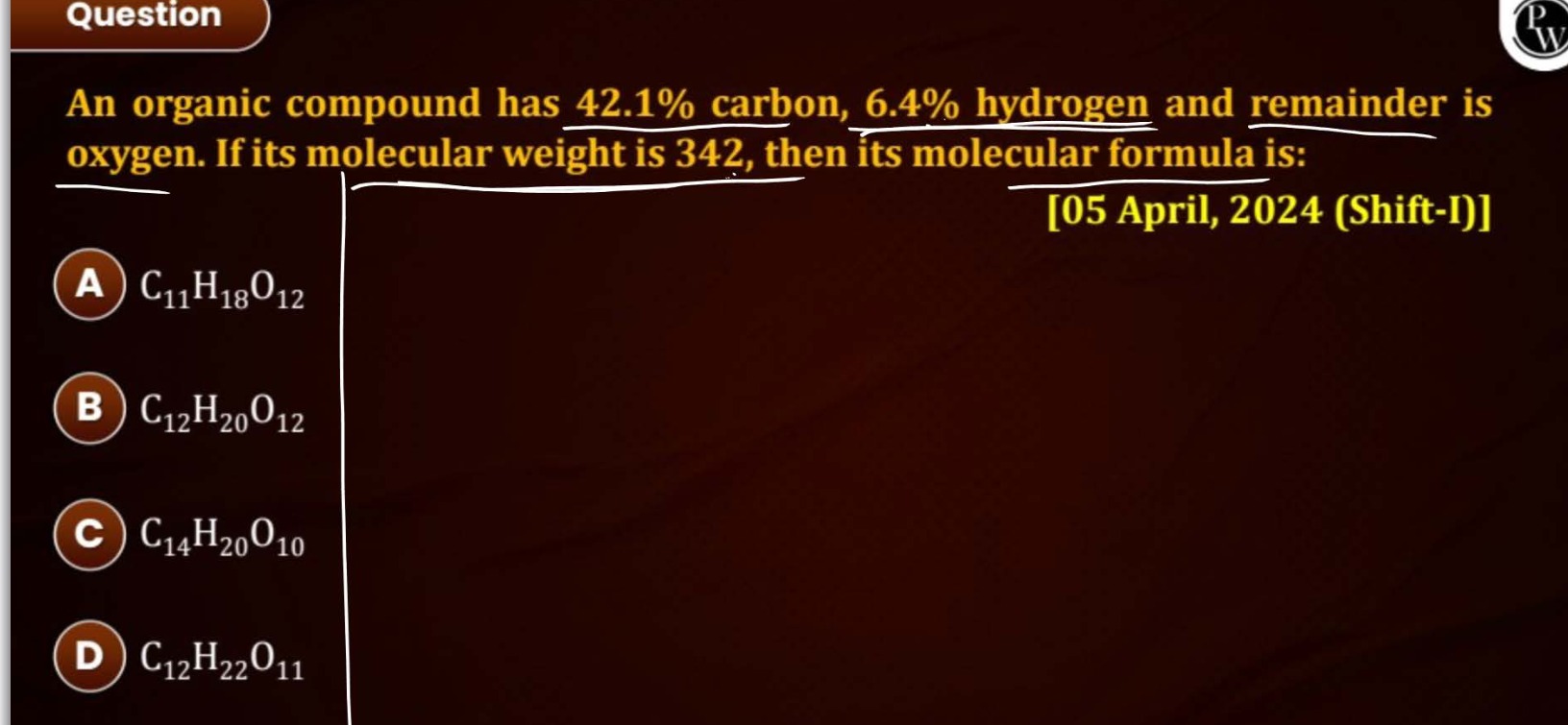Question
Question: An organic compound has 42.1% carbon, 6.4% hydrogen and remainder is oxygen. If its molecular weight...
An organic compound has 42.1% carbon, 6.4% hydrogen and remainder is oxygen. If its molecular weight is 342, then its molecular formula is:

C11H18O12
C12H20O12
C14H20O10
C12H22O11
C12H22O11
Solution
To find the molecular formula, we first determine the empirical formula.
The percentage of carbon is 42.1%, hydrogen is 6.4%, and the remainder is oxygen.
Percentage of oxygen = 100% - (42.1% + 6.4%) = 100% - 48.5% = 51.5%.
Assume 100 g of the compound. Then, the mass of each element is:
Mass of carbon = 42.1 g
Mass of hydrogen = 6.4 g
Mass of oxygen = 51.5 g
Convert the mass of each element to moles using their atomic masses (C=12.01, H=1.008, O=16.00). Using integer atomic masses (C=12, H=1, O=16) is usually sufficient for these problems unless high precision is required. Let's use integer masses first.
Moles of carbon = 42.1 g / 12 g/mol ≈ 3.5083 mol
Moles of hydrogen = 6.4 g / 1 g/mol = 6.4 mol
Moles of oxygen = 51.5 g / 16 g/mol ≈ 3.21875 mol
To find the simplest whole-number ratio, divide the number of moles of each element by the smallest number of moles (moles of oxygen):
Ratio of C = 3.5083 / 3.21875 ≈ 1.0899
Ratio of H = 6.4 / 3.21875 ≈ 1.9883
Ratio of O = 3.21875 / 3.21875 = 1
The ratios are approximately 1.09 : 1.99 : 1. These are close to 1.1 : 2 : 1 or 11/10 : 2 : 1.
Multiplying by 10 gives the ratio approximately 11 : 20 : 10.
This suggests an empirical formula of C11H20O10.
The empirical formula weight = 11×12+20×1+10×16=132+20+160=312.
The molecular weight is given as 342.
The ratio of molecular weight to empirical formula weight is n=342/312≈1.096. Since n should be an integer, there might be rounding issues with the percentages or the empirical formula derived is not correct.
Alternatively, we can use the molecular weight to directly find the number of atoms of each element in the molecular formula. Let the molecular formula be CxHyOz.
The mass of carbon in one molecule is 12x. The percentage of carbon is (12x/342)×100=42.1.
12x=342×(42.1/100)=342×0.421=144.002
x=144.002/12≈12.000
The mass of hydrogen in one molecule is 1y. The percentage of hydrogen is (1y/342)×100=6.4.
1y=342×(6.4/100)=342×0.064=21.888
y≈21.888
The mass of oxygen in one molecule is 16z. The percentage of oxygen is (16z/342)×100=51.5.
16z=342×(51.5/100)=342×0.515=176.13
z=176.13/16≈11.008
Rounding the number of atoms to the nearest integer, we get x=12, y=22, z=11.
So, the molecular formula is C12H22O11.
Let's verify the molecular weight of C12H22O11:
Molecular weight = 12×12+22×1+11×16=144+22+176=342.
This matches the given molecular weight.
Let's verify the percentages for C12H22O11:
Percentage of C = (12×12/342)×100=(144/342)×100≈42.105%
Percentage of H = (22×1/342)×100=(22/342)×100≈6.433%
Percentage of O = (11×16/342)×100=(176/342)×100≈51.462%
These calculated percentages are very close to the given percentages (42.1%, 6.4%, 51.5%).
The final answer is C12H22O11.
